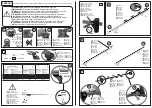
The rear seat lower anchorages are round bars, located at
the rear of the seat cushion where it meets the seat back,
and are just visible when you lean into the rear seat to
install the child restraint. You will easily feel them if you
run your finger along the intersection of the seatback and
seat cushion surfaces.
The rear seat lower anchorage bars are identi-
fied by this symbol.
In addition, there are tether strap anchorages located
behind each rear seat back.
Many, but not all restraint systems will be equipped with
separate straps on each side, with each having a hook or
connector for attachment to the lower anchorage and a
means of adjusting the tension in the strap. Forward-
facing toddler restraints and some rear-facing infant
restraints will also be equipped with a tether strap, a
hook for attachment to the tether strap anchorage and a
means of adjusting the tension of the strap.
You will first loosen the adjusters on the lower straps and
on the tether strap so that you can more easily attach the
hooks or connectors to the vehicle anchorages. Next
attach the lower hooks or connectors over the top of the
seat cover material. Then rotate the tether anchorage
cover directly behind the seat where you are placing the
child restraint and attach the tether strap to the anchor-
age, being careful to route the tether strap to provide the
most direct path between the anchor and the child
restraint. If your vehicle is equipped with adjustable rear
head restraints, raise the head restraint and, where pos-
sible, route the tether strap under the head restraint and
between the two posts. If not possible, lower the head
restraint and route the tether strap around the outboard
side of the head restraint. Finally, tighten all three straps
as you push the child restraint rearward and downward
into the seat, removing slack in the straps according to
the child restraint manufacturer’s instructions.
THINGS TO KNOW BEFORE STARTING YOUR VEHICLE
53
2
Summary of Contents for 2005 LX Magnum
Page 2: ......
Page 5: ...INTRODUCTION 5 1...
Page 8: ......
Page 81: ...UNDERSTANDING THE FEATURES OF YOUR VEHICLE 81 3...
Page 82: ...82 UNDERSTANDING THE FEATURES OF YOUR VEHICLE...
Page 83: ...UNDERSTANDING THE FEATURES OF YOUR VEHICLE 83 3...
Page 131: ...INSTRUMENTS AND CONTROLS UNDERSTANDING YOUR INSTRUMENT PANEL 131 4...
Page 132: ...STANDARD INSTRUMENT CLUSTER 132 UNDERSTANDING YOUR INSTRUMENT PANEL...
Page 133: ...PREMIUM INSTRUMENT CLUSTER UNDERSTANDING YOUR INSTRUMENT PANEL 133 4...
Page 191: ...UNDERSTANDING YOUR INSTRUMENT PANEL 191 4...
Page 195: ...Operating Tips UNDERSTANDING YOUR INSTRUMENT PANEL 195 4...
Page 196: ......
Page 227: ...STARTING AND OPERATING 227 5...
Page 265: ...WHAT TO DO IN EMERGENCIES 265 6...
Page 275: ...2 7L ENGINE MAINTAINING YOUR VEHICLE 275 7...
Page 276: ...3 5L ENGINE 276 MAINTAINING YOUR VEHICLE...
Page 277: ...5 7L ENGINE MAINTAINING YOUR VEHICLE 277 7...
Page 322: ......
Page 348: ......
Page 349: ...INDEX 10...
Page 363: ...NOTES...
Page 364: ...NOTES...
Page 365: ...NOTES...
Page 366: ...NOTES...
Page 367: ...NOTES...
Page 368: ...NOTES...
















































